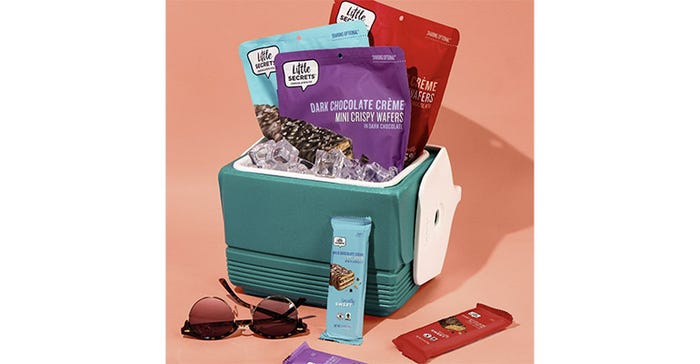Break into Whole Foods: Tips from Little Secrets CEO Vandervoet
A non-GMO, fair-trade chocolate brand executive explains what the natural food retailer will want to know before it puts your brand on its shelf.
July 12, 2022

Breaking into Whole Foods as an up-and-coming natural product can be difficult.
“Every entrepreneur needs to have that idea or spark that drives a category forward,” says Jeremy Vandervoet, the CEO and president of Little Secrets, the non-GMO, fair-trade chocolate company based in Boulder, Colorado, which does business as Little Secrets Chocolates. “It usually starts with themselves.”
For Vandervoet, who spent more a decade working at Nestlé, it began when he realized how he was snacking and eating treats with his family that didn’t mirror what he was doing professionally.
“I worked on Butterfinger and Crunch, and all these great brands, but I wasn’t bringing that home to my three kids,” says Vandervoet, who served as the director of confection and snacking marketing for Nestle S.A, overseeing its chocolate portfolio and new business development. “It sparked something in me.”
After meeting Little Secrets' co-founder and then-CEO Chris Mears, Vandervoet became the president and COO of Little Secrets in 2018, moving into the role of CEO and president in 2020 as Mears exited the brand.
Little Secrets—which was co-founded in 2014 by Brendan Synnott, who later hired Mears—launched regionally in Whole Foods in 2017. A year later, Little Secrets expanded nationally into Whole Foods. The brand currently has 11 different products (down from 18 SKUs in 2020) at Whole Foods.
Here are Vandervoet’s tips for breaking into Whole Foods.
Think like a buyer
It’s important for any up-and-coming natural product brand to understand the category, trends and what is missing, says Vandervoet. That means entrepreneurs must “think like a buyer.”
“If you can show how your brand and products fit to meet a category and consumer need, then it makes the conversation strategic and obvious why you should belong,” Vandervoet says. “You must have the 'why' you belong in addition to 'what' you bring to the table in terms of all the aspects of your product.”
Each Whole Foods store and region is unique

“I’ve heard there’s a lot of desire to allow each individual store and region to have some autonomy, to be able to bring in relevant brands and products for that region and consumer demographic,” Vandervoet says. “They acknowledge that’s kind of what’s made Whole Foods special because they nurture a lot of innovation and has always been on the leading edge and the forefront of trends.”
Still, remember Whole Foods can’t have a million SKUs in the system. “Having a lot of little tiny things everywhere isn’t efficient,” Vandervoet says. “That’s not always the best experience for the shopper.”
Find the white space gap
“A lot started with a conversation with the buyer,” Vandervoet says. “We had a point of view on our category that there was a lot of white space opportunity where Whole Foods was really overdeveloped in some segments and really underdeveloped to how people consume and eat chocolate.”
People like to consume chocolate in more formats than the traditional tablet-style chocolate bar. But there wasn’t much offered in the natural products space.
The buyer noticed a similar trend, Vandervoet says, and shared similar ideas.
“Our product roadmap and innovation came from our point of view, but it was also validated by the buyer,” Vandervoet says. “We worked on a lot of product innovations from those conversations.”
His advice to others: Find the “white space gap.”

Know the category
Chocolate comes in many formats with single serve, multi-serve for lunch boxes and snacking, and seasonal options for holidays.
“Chocolate is one of the biggest categories in the entire store,” Vandervoet says. Little Secrets was able to break in because “Whole Foods literally had 80% of their set with these chocolate tablet bars,” Vandervoet says.
Share how the brand fits into the category, why Whole Foods needs it and why the company’s product is unique and special.
“If you have some facts on your side, from a velocity standpoint, usually Whole Foods will lean in and take a risk with you, if you have a complete picture,” Vandervoet says.
Perfect the product before trying to scale
Velocity is the holy grail for entrepreneurs. Do the hard work to make sure everything is right before trying to scale, Vandervoet says, and understand your brand’s value proposition. Make sure the product resonates with customers.
Test in smaller markets first, be it a farmers market or regional chain. Get the packaging, the product, the flavor, the texture and the margins right before approaching Whole Foods. Verify there’s a velocity opportunity, Vandervoet says.
“Get everything right and don’t discount it, don’t coupon on it,” Vandervoet says. “If it’s one for $6 or two for $10, that’s fine, but don’t do a 50% discount or anything like that just to show a velocity story, because that’s unsustainable. Let it stand on its own.”

Understand what needs to be included in a presentation
From the strategic down to the tactical, the point of view on a category means understanding what's happening next at a macro level with the consumer, the category and competition. “Those are the three things you need to be super clear on super quickly,” Vandervoet says.
Ideally, show proof of concept. There are different ways to do this Vandervoet says.
“I still believe you can go into any Whole Foods and talk to the store manager and offer to set up a booth,” Vandervoet says. Offer to conduct demos inside or outside of the store, even if it’s just one location, he says. “If you sell out in two hours and you bring 100 units, you just turned 50 units per hour and that’s incredible,” Vandervoet says.
Or approach a regional-focused retail chain like PCC Community Markets in the Pacific Northwest to gather data and facts about your product.
Showing proof of concept is not a necessity, Vandervoet says, “but it definitely helps.” Share how the product or brand is already been in a region or a retailer. Share, “I’ve done X dollars per store per week,” he says. “Or have a quick fact-based selling of why this [product] will work.”
Be innovative, not a copycat. Companies get into trouble when they show up with products that are adding to an already saturated category. For example, adding another protein bar because keto is popular right now, isn’t a great strategy, Vandervoet says.
“If I show up with another protein bar, and I say, ‘Oh, protein bars are growing at 10% a year, here's another protein bar.’ That's the worst,” he says. “Don’t just come out with another version of something that already exists. That’s the easy path that you shouldn’t take.”
Be clear on pricing and promotional strategy. Clarity on your margins and how much trade you can afford to promote is critical. Part of this is understanding all the fees and costs associated with serving a customer.
“Before starting, I wish I would have understood the promotion calendar and the hurdles and expectations for how to achieve national off shelf promotions and displays,” Vandervoet says.
Understand the total trade, how it effects net sales and how that impacts the brand’s margin profile when it's on promotion.
“Whole Foods will want their margins kept whole when they're on promotion,” Vandervoet says. “If you're at a 40 margin regularly and you go on promotion, they will probably ask you to provide them funding to keep their margin whole.”
Factor that into how often the company will go on promotion, if there are fixed fees (or variable) associated with doing a promotion. Understand how the distribution and delivery will be managed and the fees associated with a distributor.
“It’s really important to have everything laid out in Excel,” Vandervoet says. “So you know your total cost to serve. It's usually more expensive than most people realize.”
About the Author(s)
You May Also Like




